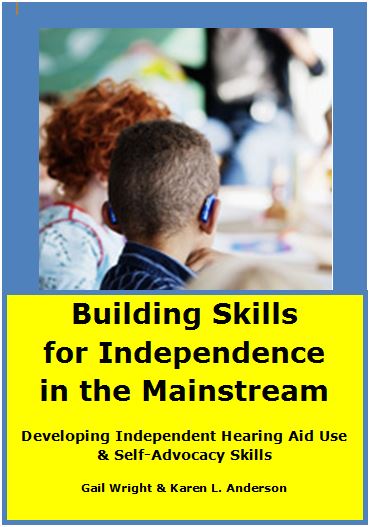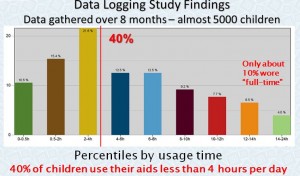Related Products
For Professionals
- Amplification
- Assessment of Student Skills, Challenges, Needs
- Early Childhood: Infants, Toddlers, Preschool
- Hearing Loss – Identification, Impact and Next Steps
- IDEA Law Summary Information
- Language and Speech Development Issues
- Legal Issues in Serving Children with Hearing Loss
- Listening (Auditory Skills) Development
- Planning to Meet Student Needs
- Self-Advocacy Skills for Students with Hearing Loss
- Self-Concept: How the Child with Hearing Loss Sees Himself
- Social Skills
- Speech Perception & Learning
Related Teacher Tools Takeout Items
Hearing Aid Retention for Young Children
Hearing Devices, Malfunction Rates, and Monitoring Requirement:
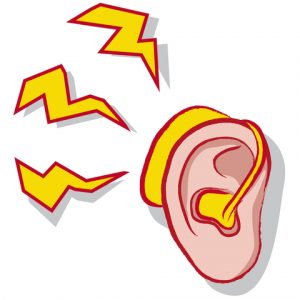 Studies have shown that hearing aids, even when worn consistently, have been found to be nonfunctional or working less than optimally for up to 50% of children, which is why daily monitoring is critical. The IDEA law requires that each public agency must ensure that the hearing aids (and cochlear implant processors) of children who are deaf or hard of hearing are functioning properly. (IDEA Sec. 300.113 (a) and (b)(1)).
Studies have shown that hearing aids, even when worn consistently, have been found to be nonfunctional or working less than optimally for up to 50% of children, which is why daily monitoring is critical. The IDEA law requires that each public agency must ensure that the hearing aids (and cochlear implant processors) of children who are deaf or hard of hearing are functioning properly. (IDEA Sec. 300.113 (a) and (b)(1)).
Studies reporting hearing aid malfunction rates include:
a) Bess, F. H. (1977). Condition of Hearing Aids Worn by Children in a Public School Setting. U.S. Department of Health, Education, and Welfare, Publication No. (OE) 77-05002.
b) Elfenbein, J. L., Bentler, R. A., Davis, J. M., & Niebuhr, D. P. (1988). Status of school children’s hearing aids relative to monitoring practices. Ear and hearing, 9(4), 212-217.
c) Gustafson, S. J., Davis, H., Hornsby, B. W., & Bess, F. H. (2015). Factors Influencing Hearing Aid Use in the Classroom: A Pilot Study. American journal of audiology, 24(4), 563-568.
As a professional working with children who are deaf or hard of hearing or a family member, you may want to know more detail about the survey research than what was presented on the Strategies for Keeping Hearing Aids on Young Children webpage.
Hearing Aid Wear Patterns Now
Click here for more information about the Phonak 2010 data logging study in which it was found that only 10% of children use hearing aids full time.
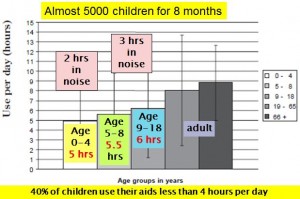
Surveys
Surveys that were sent out in February 2012: Parent Survey Pediatric Audiologist Survey
Summary of Responses by Parents and Audiologists
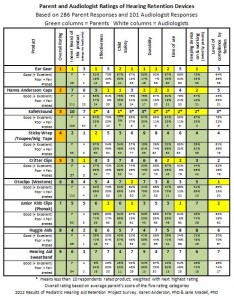 The summary graph Results of Parent and Audiologist Ratings of Hearing Aid Retention Accessories shows the percent ratings by parents and audiologists and the number of responses in each category.
The summary graph Results of Parent and Audiologist Ratings of Hearing Aid Retention Accessories shows the percent ratings by parents and audiologists and the number of responses in each category.
Acoustic Transparency
Because Ear Gear, the hats and a headband may cover the hearing aid microphone, it was important to determine acoustic transparency of each (the amount of sound blockage caused, if any). Refer to Acoustic transparancy comparisons for charts detailing acoustic responses and photos of a hearing aid with Ear Gear, Silkawear cap, Hanna Andersson cap, and a Hearing Henry Headband in places. To summarize, Ear Gear is fully transparent, the caps seem to minimally affect responses at a couple of frequencies (could fit hearing aids to adjust for this) and the headband, if worn incorrectly so it covers the microphone, will definitely cause a decrease in sound reaching the ear.
Survey Results – Written Comments
Comments by Families
What helped me understand my child’s need to use hearing devices
and what I could do to help him/her wear them all the time
Talking with other parents/attending functions for families/DHH children
Listening to a simulation of hearing loss
Watching his reaction when he actually heard something (i.e., dishwasher, airplane)
Expected developmental results if aids were worn vs if they were not worn
Speaking with an adult/seeing older children who had cochlear implants or hearing loss
Online support group of parents of kids with hearing loss
Explanation of the audiogram – being able to ‘see’ what sounds were not heard
That speech/social skills would be affected if child didn’t wear hearing aids
Concern about speech delays, especially approaching 1 year
Books (i.e., Carol Flexer; Choices in Deafness; video Dreams Spoken Here)
Parent infant child resource group from the school system / support group
Seeing development of kids early identified and late identified
Understanding brain plasticity/auditory cortex
Understanding the link between hearing aids and being ready for typical school
Watching children with hearing loss perform on YouTube videos; response to sound for the first time
I was so numb – only time helped
Getting over my fear of putting them in and how to work them.
Comments by Pediatric Audiologists
In regards to working with families, what have you tried with success?
Parent to parent support
Audiologist working with early intervention providers to help establish hearing aid wear goals for the family and provide support
Using interpreters and connecting them with families of a similar background
Counseling in a way that makes the hearing devices meaningful to the family
Providing real-world examples of strategies to increase wear time
Having the family come in for frequent data logging checks, hats
Not one thing works with each family. You must have a good working relationship to keep them coming back. Thinking outside the box and understanding what is holding them up gets you on the right path. Not everyone is ready or willing.
Work with a partner agency to provide a Mother’s Day Out situation so someone else will keep the hearing aids on to show the parents it can be done.
Encouragement by multiple audiologists as families come in to regular appointments.
A ‘to do’ list with achievable measures and a date of completion usually prior to our next appointment, e.g., complete Early Intervention evaluation, go to dispenser to pick up hearing aids,
Discussing the family’s specific challenges with them
Time and patience. Keeping in close communication and not closing the door simply because the family has barriers or is taking a longer time to make choices.
Social work intervention
Help families understand their child’s hearing loss and what their child is missing by not having their hearing aids on.



